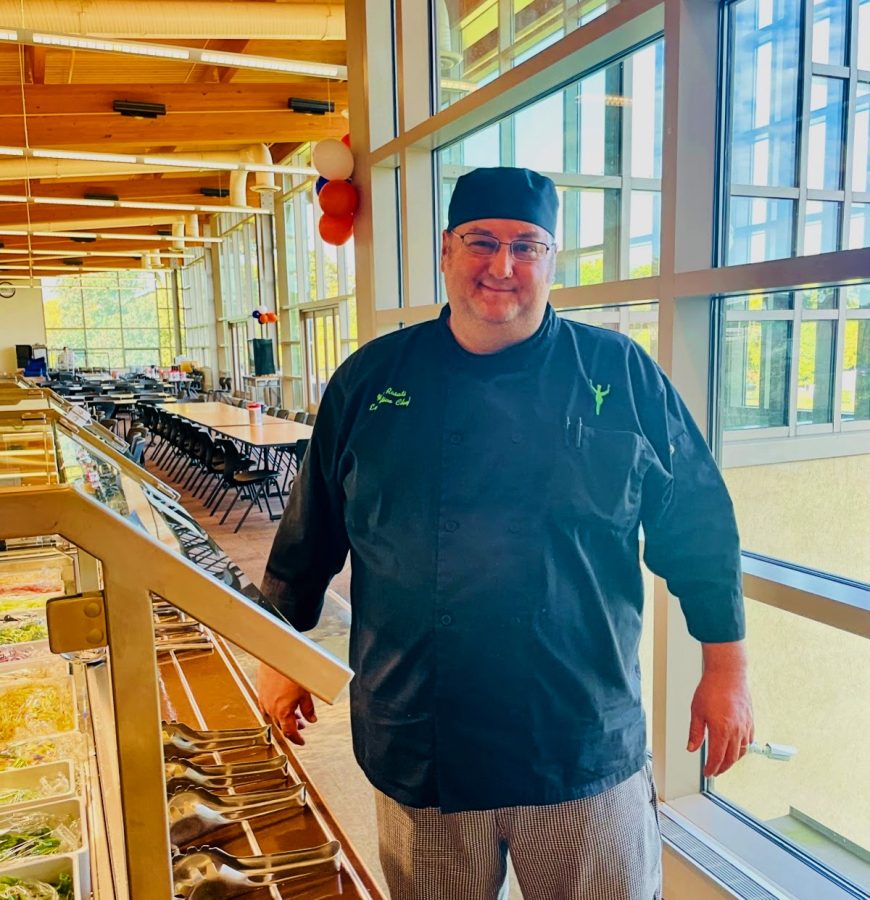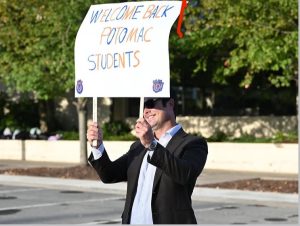Talking Sustainability with Potomac’s Executive Chef Wes Rosati
A Behind-the Scenes Conversation and Tour
Executive Chef Wes Rosati next to the salad bar in Potomac’s cafeteria
October 27, 2022
Where does our food come from? Where does it go? I interviewed Mr. Wes Rosati, Potomac School’s executive chef, who leads the team of our food service contractor, Meriwether Godsey. I wanted to learn about how Potomac’s food service impacts sustainability and where improvement is possible. The topic is significant. Approximately one-third of food produced globally is wasted. The carbon footprint of global food waste reaches 3.3 billion tons of CO2, which amounts to 8% of worldwide carbon emissions. Researchers established that reducing food waste curbs more CO2 emissions than any other climate-crisis mitigation endeavor, including solar power, reforestation, and electric transportation. Americans waste about one pound of food per person, daily.
Mr. Rosati was welcoming and forthcoming as we explored issues we both care about deeply.
Editor’s note: The following interview has been lightly edited for clarity and length.
What happens to all the food that never reaches students’ plates, the leftover lunches that don’t get served?
We try very hard to prepare things all throughout the lunch period [instead of prepping a fixed amount of food all at once]. Using this method, we don’t have a ton of food left at the end, but of course there’s always food left.
Food Rescue USA set us in contact specifically with a local food bank in Fairfax that comes once or twice a week to collect food for us if we can’t reuse it. Sometimes, if we have, for example, black beans left today, we’ll turn them into soup for another day, which is a very common practice in restaurants.
As long as you cool things down properly and treat them carefully, you can reuse the leftover food. The things that we can’t turn into something else or can’t use in a salad or can’t use for another purpose, we will donate to the food bank. I text them, they come once or twice a week, and they’ll take things like leftover sandwiches. We really try very hard to not have a ton of waste.
What about things like leftover meat or food that can’t be saved, even for the food bank? What happens to it?
It depends on how much of it there is. Today we have ground beef, in tacos, so it could be turned into chili another day. I’ve been here a year now, so I have a year’s worth of data that I’ve collected of how many trays we go through of everything. We try really hard to kind of hit that number. You’ll see the cooks cooking an extra 10 pounds or something along the way. So we don’t just cook a ton in the beginning and then hope that that lasts. We try to cook as we go so that we really don’t have a ton of waste left.
But chicken leftovers, things like that, we can use for the salad bar. We handle the food properly so we can reuse it in those ways.
[Note: I followed up with Mr. Rosati about exactly how much food produced for the dining room is unable to be salvaged. He estimates it to be about 5-8%.]
If there is waste, what happens to it? Can you just throw it in the garbage, or does it have to go through a special process?
With meats, it usually goes into the garbage.
What about vegetables? Can those be composted?
Cooked vegetables are a little tricky with compost. We do have a company set up that comes and collects compost for us.
But that deal hasn’t always worked out well. We can’t have things get backed up and have a bug problem or something like that, so…we can’t compost ourselves and so we’ve relied on another company coming to help us.
But I think we’re trying to get that system improved for us. They need to handle raw vegetable scraps, mostly. Leftover meats that are still good and edible that I can’t turn into something, we put them in a disposable pan and the food bank would take them either Wednesday or Friday of the week.
Do you know where the produce comes from? Is it local, or imported?
I buy produce from two different companies. One of them is called the Common Market, based out of Philadelphia, and they source locally from farms. And they can tell me where they buy their stuff. They buy from Virginia all the way up to Pennsylvania.
So I can usually see when things are coming from Maryland, Pennsylvania, Virginia. By the time you get to winter, what we could actually serve in terms of local fruits is a little sparse.
That’s mostly what’s imported at that point. But we do go out of our way to get local food. You won’t see zucchini and squash in here anymore because the time of the year is gone. You’ll see brussel sprouts and butternut squash and things like that, that are a little more seasonal for the winter. I would say that 50 to 60% of our produce comes from a couple of states near us.
I’ve been buying local tomatoes since we started, but again, we’re almost at the first freeze and then that’ll be over. I can’t buy my local tomatoes anymore. Local apples will be great for a couple more months as well.
Florida citrus is just starting, and so we get most of our citrus, our clementines, our oranges, from California and Florida. But a lot of it is within the states. Some of it’s local and then some of it’s affordable.
In terms of sustainability, where do you think there’s room for improvement in this cafeteria?
I think with the recycling of our products. And educating the students on not taking disposable products, I see people getting to go boxes all the time and sitting down and eating here. There’s just so much paper waste that happens that I think could be improved upon. And with that waste comes the plastic spoons and forks.
And then for us, a recycling program for the kitchen. We open up cans every day for tomato sauce or beans or whatever it might be. I think that that could be something we haven’t been able to get in a place yet that could be a good win.
Is there anything else you’d like to add?
I mean, we work very hard to cook fresh food every day. The cooks care about waste a lot, and they don’t like to see when there’s a day when we have a lot of biscuits left over or something like that.
And so everybody works really hard and try to be sustainable. It’s one of the core values. You’ll see it on some of our shirts. It’s one of the core values of our company as well.
I enormously appreciated Mr. Rosati’s willingness to speak with me, and his commitment to sustainable, healthy food. Our conversation was open and thought-provoking; we agreed that there is room for growth in the Potomac community’s green efforts. For example, perhaps there is a way to shift from the use of disposable dining boxes to reusable containers. When confronted with statistics about emissions, pollution, and prodigal food waste, mitigating our environmental footprint can seem daunting–if not futile. But it doesn’t have to be hard: the most effective solutions to climate change are literally served to us on our plates. Let’s not dispose of them.





